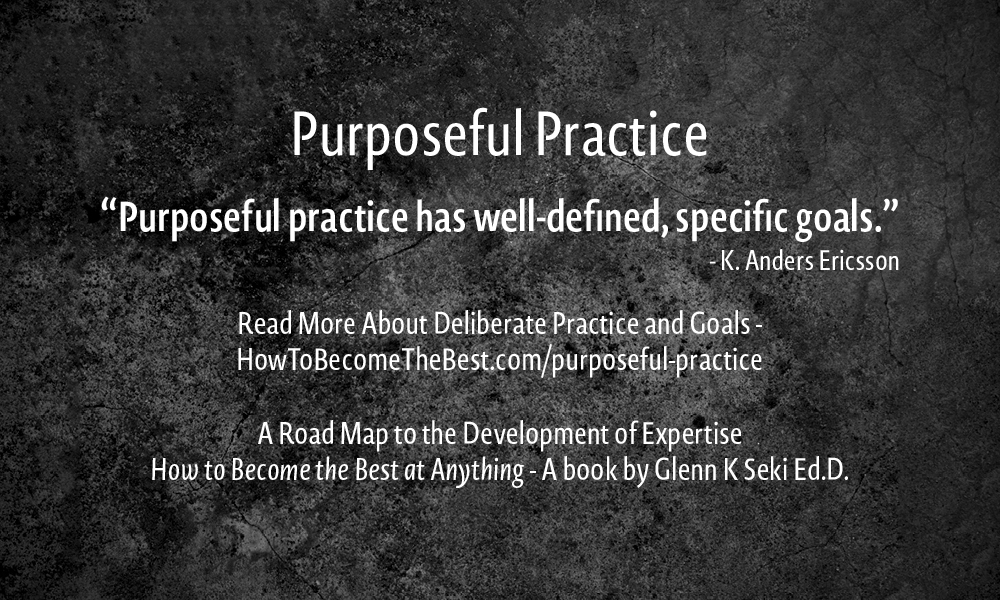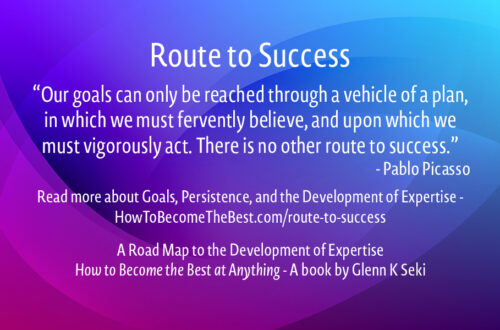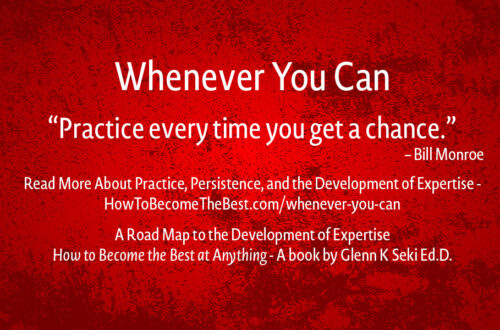“Purposeful practice has well-defined, specific goals.” – K. Anders Ericsson
A Road Map to the Development of Expertise
How to Become the Best at Anything – A book by Glenn K Seki Ed.D.
Goals
An excerpt from How To Become The Best at Anything, Chapter 6, A Goal and a Plan
“You need to have a specific ultimate goal. Let’s say you want to win an Olympic gold medal in swimming in the 200-meter freestyle. You have a specific ultimate goal, which is a good start because you know your final destination.
When I was in graduate school in biology at UCLA one of my classes was a graduate seminar consisting of three students and two professors (George “Bart” Bartholomew and Thomas Howell, both top in their fields). One day in class the professors posed the question, “What does a migrating bird need to know to be able to find its way to winter nesting grounds?” All of us thought for awhile and I timidly answered, “They need to know where they are, and they need to know where they are going.” One professor said, “That is correct.” And I stopped shaking.
To navigate to anywhere you need to know your starting point and where you are going. Once you know that, you can determine the direction and the amount of time it will take you to reach your final destination. You will need a navigation system to guide you along your way. Let’s call this your path.”
Your Starting Point
“You must have a realistic evaluation of your starting point. What do you know? What don’t you know? What can you do? There are so many aspects to developing expertise in your chosen domain. How do you know what you know and what you don’t know? This is one of the reasons why you need a coach. More on coaches in the next chapter.
What is your starting point? You might be part way to your goal already. You might be very close to your ultimate goal and just need a little help to get to your final destination. You might know your starting point already. If not, you need to figure it out.
When I was 17 years old and a freshman in college, my grandfather brought a Canon FTb single lens reflex camera home from a trip to Japan. He gave the camera to my father, who gave it to me.
I always liked taking pictures with a brownie point-and-shoot camera as a kid, but that was it. Now I had this really cool camera. So, I went and bought a beginner’s book on photography and started from the beginning, with no real prior knowledge of photography.
What was my starting point? The very beginning.”
Goals for Practice
“When you are planning a practice session, set a specific goal for that particular practice. Just like setting your ultimate goal, set your practice goals the same way. You know your starting point (current ability level), now determine where you want to be at the end of the practice.
When I was learning photography, I wanted to be able to focus faster and consistently (there were no auto focus cameras back then). I went down to the beach with a 200mm telephoto lens and would try to focus on the seagulls in flight. The seagulls had to fill the frame and be in sharp focus. It took awhile but I was able to consistently take sharp pictures of seagulls in flight. My starting point, I was not able to focus consistently on moving objects. My practice goal, to consistently take sharp focused pictures of seagulls in flight.
For my USPSA/IPSC pistol sport there is what is known as a Bill Drill. The steps of a Bill Drill are (1) start with your wrists above your shoulders, (2) draw your gun from the holster, and (3) fire six rounds into the “A” zone (center of the target) of a standard USPSA target placed at seven yards as fast as you can. The goal of this drill is to be able to perform the Bill Drill in two seconds or less.
With this drill you are practicing your draw, grip on the gun, stance, sight tracking, proper visual reference, recoil management, and trigger manipulation, not to mention controlling your nerves, mental focus, etc. This may sound to some like a simple drill, but it is very hard to accomplish, especially in the beginning.
My goal was to accomplish the Bill Drill in two seconds or less. My starting point? I went out and tried the Bill Drill in practice. I don’t remember what my time was, but I remember it was either over two seconds or if I achieved two seconds or less the shots were all over the target. So, I broke the Bill Drill down into its’ component parts. First, what draw time do I need to have with an “A” zone hit and what average split time do I need to have between shots to have a time under two seconds? I worked on my draw, grip, etc. until I could consistently accomplish a first shot “A” zone hit in 1.15 seconds or less. I then worked on my split times between shots until I could consistently accomplish .15 second splits or less. Eventually I was able to consistently accomplish a Bill Drill in under two seconds.
I set my goal and determined my starting point. This gave me my path to accomplishing my goal. Use the same process for accomplishing any of your goals.”
Deliberate Practice and Automaticity
An excerpt from How To Become The Best at Anything, Chapter 8, Deliberate Practice and Learning
“To become the best takes practice, lots and lots of practice. I have mentioned the 10,000-hour rule. It takes about 10,000 hours of practice to get really good at something and not just any type of practice, but deliberate practice. Deliberate practice is practicing to get better.
The classic example is a man who has gone golfing almost every weekend for the past twenty years. He has a great interest in the sport and has fun with it. He reaches a certain level of expertise and plateaus there after about seven years. He is good enough to win occasionally playing, against his friends. He has fun, although after twenty years of practice why hasn’t he become a great golfer? Because he was not practicing to get better, he was not using deliberate practice, he was just participating in the sport. When you practice, you need to be practicing something that will help you become better.
10,000 hours of practice comes out to about 5 to 6 hours a day, 4 to 6 days a week, for 7 to 10 years of deliberate practice. That’s what it takes to become one of the best, depending on the domain. This is a lot of deliberate practice!
What if you want to become the best in a domain that is a new sport or profession? If levels of expertise have not been fully established, then you can become the best in far fewer hours of deliberate practice. This is because no one has practiced and established themselves in the domain yet. The bar of expertise is being reset all the time. As time goes by, the 10,000 hours will be reached, and fully automated sequences will be in place making it harder for novices to attain high levels of expertise. Those that started first in the new sport or profession, as long as they continue to improve, will remain on top.”
Automaticity
“Deliberate practice results in the automation of a sequence of steps. It is automated so you don’t have to consciously think about it while you are doing it, you just do it. Some people call this “muscle memory.” I don’t like this term since muscles have no memory. Repeat after me, “muscles have no memory.” This automated sequence of steps is in your memory, in your brain. Your brain places this automated sequence of steps into nice and neat “chunks,” so you do not have to consciously think about them.
Remember when you were first learning to drive a car. It was very difficult and stressful because you had to remember to do so many new things at the same time. Most DMVs require a minimum of 50 hours supervised behind-the-wheel experience before you may apply for a license if you are under 18. It takes 100 hours of deliberate practice before a complex sequence begins to fully automate. That is why it is so difficult in the beginning to drive a car in traffic.
Now that you have been driving for several years, when you are commuting home after work, you probably don’t think about driving, you suddenly find yourself at the freeway off-ramp and almost home. That is because your diving has become automated, if something unusual occurs, you instantly snap back into conscious thinking mode and make corrections to your driving.
This is also why you must practice good driving habits in the beginning, so you don’t automate a bad habit. Once a bad habit is automated, it is very hard to un-automate it and replace it with the correct automation. Learn the basics correctly the first time. This goes for all practice, for all domains.”





